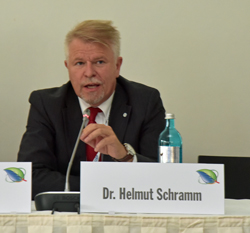
Researchers at The Samuel Roberts Noble Foundation, University of Minnesota and the National Center for Genome Resources revealed their advancements in sequencing the alfalfa genome on July 13 at the North American Alfalfa Improvement Conference in Madison, Wisconsin.
Noble Foundation along with researchers from the University of Minnesota and the National Center for Genome Resources have made significant advancements in sequencing the alfalfa genome. The research was presented during the North American Alfalfa Improvement Conference held in Madison, Wisconsin. According to Dr. Maria Monteros, Ph.D., alfalfa is one of the most complex plant genome to sequence and today the majority of sequencing as been completed.
Scientists are using sequencing to determining the order of the four chemical building blocks that make up a strand of DNA. The organism’s complete set of DNA is its genome, or all of the genetic instructions that determines how the organism grows, develops and interacts with its environment.
“The genome sequence is like a combination inventory, blueprint and roadmap for scientists to focus on genes and pathways that are most important for plant, animal and ecosystem health,” explained Nevin Young, Ph.D., University of Minnesota plant pathology professor. “With alfalfa’s genome sequence, researchers know which genes are likely to affect disease resistance, digestibility and ability to produce natural nitrogen fertilizer. This will allow us to breed plants for higher quality and production.”
 Researchers also note that alfalfa can satisfy its nitrogen needs through a naturally occurring symbiotic relationship with bacteria called rhizobia in the soil. This invaluable trait removes the need to use additional nitrogen fertilizer inputs to support plant growth. Therefore, understanding the genome sequence could lead to alfalfa plants with increased ability to survive in stressful environments such as drought and animal grazing. It could also produce higher biomass yields when baled as hay, extend its growing season, and adapt better to different soil types and nutrient levels.
Researchers also note that alfalfa can satisfy its nitrogen needs through a naturally occurring symbiotic relationship with bacteria called rhizobia in the soil. This invaluable trait removes the need to use additional nitrogen fertilizer inputs to support plant growth. Therefore, understanding the genome sequence could lead to alfalfa plants with increased ability to survive in stressful environments such as drought and animal grazing. It could also produce higher biomass yields when baled as hay, extend its growing season, and adapt better to different soil types and nutrient levels.
The goal of the sequencing is to allow other scientists to use the information for practical purposed to support plant breeding research and ultimately for farmers to grow the crop using less inputs such as fertilizers and water.
This advancement in the alfalfa genoming serves as the backbone of research data included in the alfalfa breeder’s toolbox, which will provide the international science community with access to publicly available tools and information for alfalfa improvement. The alfalfa genome sequence ties in with the Noble Foundation’s Forage 365 initiative, which seeks to extend the grazing season and enable livestock producers to reduce hay consumption.











